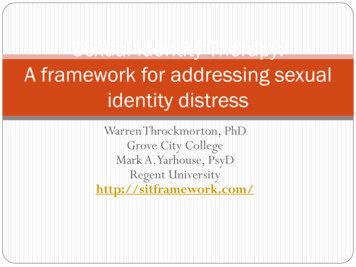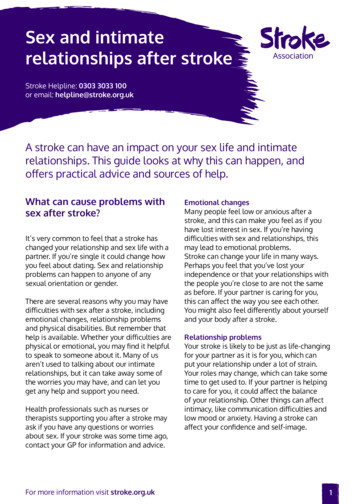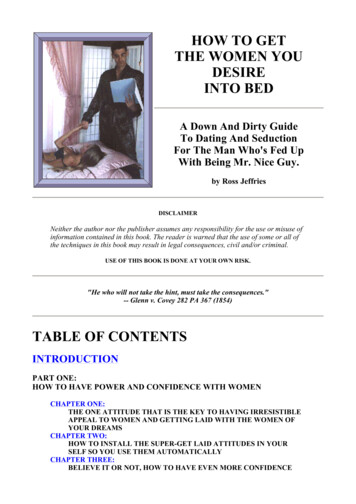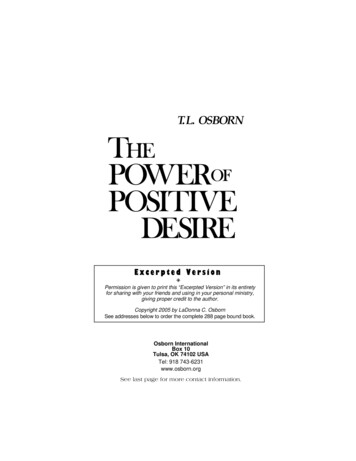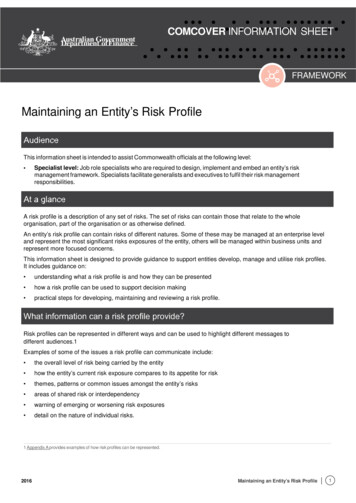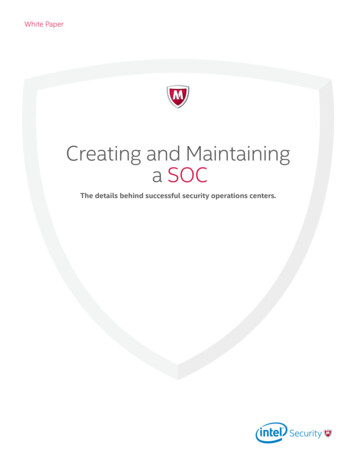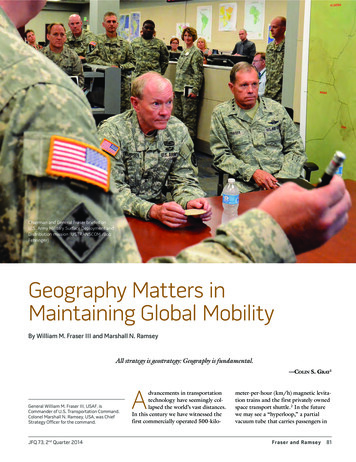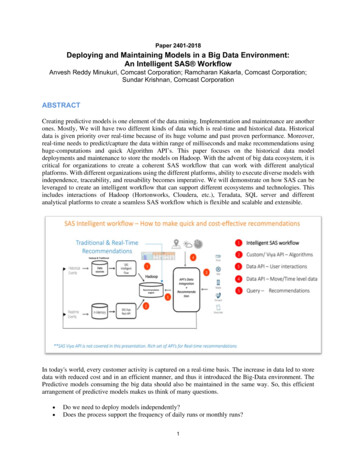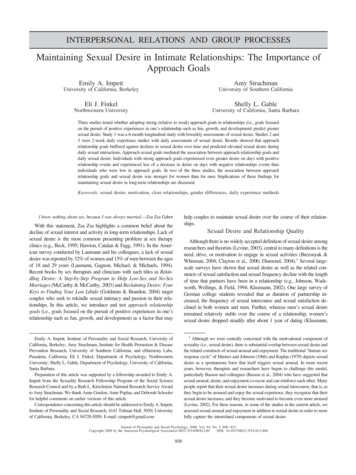
Transcription
INTERPERSONAL RELATIONS AND GROUP PROCESSESMaintaining Sexual Desire in Intimate Relationships: The Importance ofApproach GoalsEmily A. ImpettAmy StrachmanUniversity of California, BerkeleyUniversity of Southern CaliforniaEli J. FinkelShelly L. GableNorthwestern UniversityUniversity of California, Santa BarbaraThree studies tested whether adopting strong (relative to weak) approach goals in relationships (i.e., goals focusedon the pursuit of positive experiences in one’s relationship such as fun, growth, and development) predict greatersexual desire. Study 1 was a 6-month longitudinal study with biweekly assessments of sexual desire. Studies 2 and3 were 2-week daily experience studies with daily assessments of sexual desire. Results showed that approachrelationship goals buffered against declines in sexual desire over time and predicted elevated sexual desire duringdaily sexual interactions. Approach sexual goals mediated the association between approach relationship goals anddaily sexual desire. Individuals with strong approach goals experienced even greater desire on days with positiverelationship events and experienced less of a decrease in desire on days with negative relationships events thanindividuals who were low in approach goals. In two of the three studies, the association between approachrelationship goals and sexual desire was stronger for women than for men. Implications of these findings formaintaining sexual desire in long-term relationships are discussed.Keywords: sexual desire, motivation, close relationships, gender differences, daily experience methodshelp couples to maintain sexual desire over the course of their relationships.I know nothing about sex, because I was always married.—Zsa Zsa GaborWith this statement, Zsa Zsa highlights a common belief about thedecline of sexual interest and activity in long-term relationships. Lack ofsexual desire is the most common presenting problem at sex therapyclinics (e.g., Beck, 1995; Hawton, Catalan & Fagg, 1991). In the American survey conducted by Laumann and his colleagues, a lack of sexualdesire was reported by 32% of women and 15% of men between the agesof 18 and 29 years (Laumann, Gagnon, Michael, & Michaels, 1994).Recent books by sex therapists and clinicians with such titles as Rekindling Desire: A Step-by-Step Program to Help Low-Sex and No-SexMarriages (McCarthy & McCarthy, 2003) and Reclaiming Desire: FourKeys to Finding Your Lost Libido (Goldstein & Brandon, 2004) targetcouples who seek to rekindle sexual intimacy and passion in their relationships. In this article, we introduce and test approach relationshipgoals (i.e., goals focused on the pursuit of positive experiences in one’srelationship such as fun, growth, and development) as a factor that maySexual Desire and Relationship QualityAlthough there is no widely accepted definition of sexual desire amongresearchers and theorists (Levine, 2003), central to many definitions is theneed, drive, or motivation to engage in sexual activities (Brezsnyak &Whisman, 2004; Clayton et al., 2006; Diamond, 2004).1 Several largescale surveys have shown that sexual desire as well as the related constructs of sexual satisfaction and sexual frequency decline with the lengthof time that partners have been in a relationship (e.g., Johnson, Wadsworth, Wellings, & Field, 1994; Klusmann, 2002). One large survey ofGerman college students revealed that as duration of partnership increased, the frequency of sexual intercourse and sexual satisfaction declined in both women and men. Further, whereas men’s sexual desireremained relatively stable over the course of a relationship, women’ssexual desire dropped steadily after about 1 year of dating (Klusmann,1Emily A. Impett, Institute of Personality and Social Research, University ofCalifornia, Berkeley; Amy Strachman, Institute for Health Promotion & DiseasePrevention Research, University of Southern California, and eHarmony Labs,Pasadena, California; Eli J. Finkel, Department of Psychology, NorthwesternUniversity; Shelly L. Gable, Department of Psychology, University of California,Santa Barbara.Preparation of this article was supported by a fellowship awarded to Emily A.Impett from the Sexuality Research Fellowship Program of the Social ScienceResearch Council and by a Ruth L. Kirschstein National Research Service Awardto Amy Strachman. We thank Amie Gordon, Anne Peplau, and Deborah Schoolerfor helpful comments on earlier versions of this article.Correspondence concerning this article should be addressed to Emily A. Impett,Institute of Personality and Social Research, 4143 Tolman Hall, 5050, Universityof California, Berkeley, CA 94720-5050. E-mail: eimpett@gmail.comAlthough we were centrally concerned with the motivational component ofsexuality (i.e., sexual desire), there is substantial overlap between sexual desire andthe related constructs of sexual arousal and enjoyment. The traditional “human sexresponse cycle” of Masters and Johnson (1966) and Kaplan (1979) depicts sexualdesire as a spontaneous force that itself triggers sexual arousal. In more recentyears, however, therapists and researchers have begun to challenge this model,particularly Basson and colleagues (Basson et al., 2004) who have suggested thatsexual arousal, desire, and enjoyment co-occur and can reinforce each other. Manypeople report that their sexual desire increases during sexual intercourse; that is, asthey begin to be aroused and enjoy the sexual experience, they recognize that theirsexual desire increases, and they become motivated to become even more aroused(Levine, 2002). For these reasons, in some of the studies in the current article, weassessed sexual arousal and enjoyment in addition to sexual desire in order to morefully capture the interrelated components of sexual desire.Journal of Personality and Social Psychology, 2008, Vol. 94, No. 5, 808 – 823Copyright 2008 by the American Psychological Association 0022-3514/08/ 12.00DOI: 10.1037/0022-3514.94.5.808808
APPROACH GOALS AND SEXUAL DESIRE2002). Another study documented that the association between relationship duration and reduced frequency of intercourse was stronger than theassociation between age and sexual frequency (Johnson et al., 1994). Inshort, sexual desire typically peaks at the beginning of relationships whenpartners are just getting to know each other and often decreases over thecourse of relationships (Basson, 2002; Levine, 2003).Because both sexual desire and sexual satisfaction play keyroles in determining the quality of intimate relationships, relationship scholars and therapists should care about the decline of sexualdesire. Many studies of couples who voluntarily attend sex therapyclinics provide support for the idea that low sexual desire isassociated with decreased levels of relationship satisfaction, bothfor individuals with low desire and for their partners (e.g., McCabe, 1997; Trudel, Landry, & Larose, 1997). More recent studieshave also documented similar associations between sexual desireand relationship satisfaction in community samples of marriedcouples (Brezsnyak & Whisman, 2004) and dating couples(Regan, 2000; Sprecher, 2002). Further, many empirical studieshave documented a significant positive association between sexualsatisfaction and dating and marital quality (Yeh, Lorenz, Wickrama, Conger, & Elder, 2006; see review by Sprecher & Cate,2004). Sex therapists have similarly noted that when sexualityfunctions well in a marriage, it contributes substantially to themarital bond. However, dysfunctional or nonexistent sexualityrobs the marriage of intimacy, satisfaction, and stability (McCarthy, 1999).While a wealth of research has shown that sexual desire contributes to relationship quality and stability, less research hasinvestigated the factors that help promote and sustain sexual desirein relationships. In this article, we suggest that the adoption ofapproach relationship goals may help couples to maintain sexualdesire over the course of their relationships. We first introduce theapproach–avoidance theoretical perspective guiding this researchand apply this theory to the study of sexuality in intimate relationships. We then present the results of three studies designed to testour hypotheses concerning the link between approach relationshipgoals and sexual desire. Finally, we discuss the implications of thisresearch for couples and sex therapists who wish to promotehealthy sexual functioning in long-term relationships.Approach–Avoidance Motivational FrameworkSeveral theories of motivational processes postulate the existence of distinct approach (also called appetitive) and avoidance(also called aversive) motivational systems (see reviews in Carver,Sutton, & Scheier, 2000; Elliot & Covington, 2001). For instance,Gray’s (1987) neuropsychological model of motivation posits appetitive and aversive motivational systems, referred to as thebehavioral approach system (BAS) and the behavioral inhibitionsystem (BIS; see also Carver & White, 1994). Specifically, theBAS is an appetitive system that is primarily sensitive to positivestimuli or signals of reward, whereas the BIS is an aversive systemthat is primarily sensitive to negative stimuli or signals of punishment. Gray (1990) has shown that the BAS is associated withfeelings of hope, whereas the BIS is associated with feelings ofanxiety. In a study of motivational dispositions and daily events,Gable, Reis, and Elliot (2000) found that participants with higherBAS sensitivity reported experiencing more daily positive affectthan those with lower BAS sensitivity, while participants with809higher BIS sensitivity reported experiencing more daily negativeaffect than those with lower BIS sensitivity.The approach–avoidance motivational distinction has been particularly helpful in understanding motivation in interpersonal relationships. Basing their work on that of early social motivationtheorists (e.g., Boyatzis, 1973; Mehrabian, 1976), Gable and colleagues have recently distinguished between approach and avoidance social goals (Elliot, Gable, & Mapes, 2006; Gable, 2006b).Whereas approach social goals direct individuals toward potentialpositive outcomes such as intimacy or growth in their relationships, avoidance social goals direct individuals away from potential negative outcomes such as conflict or rejection. For example,in a discussion about child care, a husband who has strong approach goals may be concerned with wanting the discussion to gosmoothly and wanting both partners to be happy with the outcome.In contrast, a husband with strong avoidance goals may be moreconcerned with avoiding conflict about child care and preventingboth partners from being unhappy with the outcome (Gable,2006b). These goals are flexible forms of regulation that may takeon diverse manifestations; they may focus on a specific relationship or relationships in general, they may focus on close relationships or acquaintances, and they may focus on a variety of relational concerns such as sexuality, intimacy, and parenting(Dowson & McInerney, 2003; Sorkin & Rook, 2004). In thisarticle, we are specifically concerned with individuals’ goals intheir romantic relationships (in Studies 1 and 2) and in theirinterpersonal relationships more generally (in Study 3).Just as BAS and BIS are associated with distinct emotionaloutcomes, research has also shown that approach and avoidancesocial goals predict different social outcomes (Gable, 2006b; Impett, Gable, & Peplau, 2005). In three short-term longitudinalstudies, approach goals were associated with more positive socialattitudes, more satisfaction with social bonds, and less loneliness,whereas avoidance goals were associated with more negative social attitudes, relationship insecurity, and more loneliness (Gable,2006b). In a daily experience study of dating couples, on dayswhen individuals made sacrifices for approach motives, they experienced greater positive affect and relationship satisfaction; ondays when they sacrificed for avoidance motives, they experiencedgreater negative affect, less relationship satisfaction, and moreconflict (Impett, Gable, & Peplau, 2005). In short, the approachsystem (but not the avoidance system) is associated with positiveemotional and social outcomes.Applying the Approach-Avoidance MotivationalFramework to SexualityCentral to many definitions of sexual desire is the need ormotivation to engage in sexual activities or the pleasurable anticipation of such activities in the future (Brezsnyak & Whisman,2004; Clayton et al., 2006; Diamond, 2004). In short, sexual desireinvolves the potential rewards and the positive emotional experience that are characteristic of the approach motivational system. Inaddition to predicting positive affect and relationship satisfaction(Gable, 2006b; Gable et al., 2000; Impett, Gable, & Peplau, 2005),approach relationship goals may also be associated with dailysexual desire and the maintenance of sexual desire over time. Onepossible reason why approach relationship goals may promotesexual desire concerns people’s motives or reasons for engaging in
810IMPETT, STRACHMAN, FINKEL, AND GABLEsexual activity with a partner (Cooper, Shapiro, & Powers, 1998;Impett, Peplau, & Gable, 2005). People who pursue positive experiences, such as growth and development, in their relationshipsmay view sexual activity as one way to create positive, intimateexperiences with a partner. Therefore, compared with people withweak approach relationship goals, those with strong approachrelationship goals may think more about sex, be more sensitive totheir partners’ cues, create environments that promote intimateinteraction, and act more readily upon potential sexual encounters.Previous research has shown that approach motives and goals areprimarily linked to outcomes through an exposure process (Elliotet al., 2006; Gable, 2006b; Gable et al., 2000). That is, individualswith strong approach goals or motives tend to report experiencinga greater number of positive events (but not fewer negativeevents). Therefore, individuals with strong approach goals arelikely to experience a greater number of positive events andpositive emotions (including desire) with their partners. Because ofthese previous findings, we believe that approach goals in closerelationships will be more strongly related to sexual desire thanwill avoidance goals because approach goals are primarily associated with positive events (likely through processes that lead toincreased exposure) and avoidance goals have not been linkedreliably to positive events.It is also likely that people with strong approach goals for theirrelationships in general may also engage in daily sexual activityfor approach reasons such as pleasing a partner or enhancingintimacy in the relationship. Repeatedly engaging in sex for approach reasons, in turn, may promote greater sexual desire. Arecent cross-sectional study of late adolescent girls showed thatengaging in sex for approach goals (e.g., to express love, forphysical attraction) was positively associated with sexual satisfaction (Impett & Tolman, 2006). Based on this research, we predicted that individuals with strong approach relationship goalswould report engaging in sexual activity for approach reasons, inturn, promoting greater sexual desire.Gender and Sexual DesireMany lines of research demonstrate that men show more interestin sex than do women (see review by Baumeister, Catanese &Vohs, 2001). For example, men think about sex more often thanwomen do (Laumann et al., 1994), report more frequent sexualfantasies (Beck, Bozman, & Qualtrough, 1991), and report greaterfeelings of sexual desire (Leitenberg & Henning, 1995). Further,men and women differ in their preferred frequency of sex; whendating and marriage partners disagree about sexual frequency, menusually want to have sex more often than women (Julien, Bouchard, Gagnon, & Pomerleau, 1992; Sprecher & Regan, 1996).Complementing these descriptive gender differences is researchdemonstrating that women’s sexual desire may be more closelytied to the interpersonal aspects of the relationships than is men’sdesire (see review by Peplau, 2003). For instance, when Regan andBerscheid (1999) asked young adults to define sexual desire, menwere more likely than women to emphasize physical pleasure andsexual intercourse, whereas women were more likely than men toemphasize the emotional or relational side of sexual desire.Women are more likely than men to engage in sex to enhancecommitment and express love for their partners (Basson, 2002;Impett, Peplau, & Gable, 2005). Taken together, these lines ofresearch suggest that women’s sexual desire may be more sensitivethan men’s to relationship dynamics, and in particular, to women’sgoals for the relationship. For this reason, a secondary goal of thecurrent research was to explore whether the association betweenapproach relationship goals and sexual desire is stronger forwomen than for men.Hypotheses and Research OverviewWe conducted three studies of individuals in dating relationships to test several predictions from approach–avoidance motivational theory about the maintenance of sexual desire in datingrelationships. Study 1 was a 6-month longitudinal study of individuals in dating relationships that included biweekly assessmentsof sexual desire. In this study, we tested the hypothesis that theadoption of approach relationship goals would buffer against declines in sexual desire over time. Study 2 was a 2-week dailyexperience study of individuals in dating relationships designed toextend the findings from Study 1 by testing whether approachsexual goals would mediate the link between approach relationshipgoals and sexual desire. Study 3 was an additional 2-week dailyexperience study that included (a) a more general measure ofsocial (as opposed to relationship-specific) approach goals, (b) amore detailed measure of sexual goals that distinguished betweenself-focused and other-focused goals, and (c) measures of positiveand negative relationship events. These last measures enabled us toexamine how perceptions of the daily relationship climate influence sexual desire and whether relationship events moderate theassociation of approach goals with sexual desire. In all threestudies, we conducted additional analyses to examine the effects ofapproach goals on sexual desire beyond the influence of how longpeople have been involved in their relationships, how satisfied theyare with their partners, and how frequently they engage in sexualactivity. Finally, in all three studies, we examined gender as amoderator of the link between approach goals and sexual desire,exploring the possibility that the association may be stronger forwomen than for men as women’s sexual desire may be particularlysensitive to women’s goals for their relationships.Study 1We tested three main predictions in a 6-month longitudinalstudy of college students in dating relationships: (a) Individualswith strong approach goals would report higher sexual desire atstudy entry than individuals with weak approach goals; (b) individuals who began the study with weak approach relationshipgoals would experience decreases in sexual desire over the courseof the study, whereas individuals who began the study with strongapproach relationship goals would not experience such decreases;and (c) avoidance relationship goals would not be significantlyassociated with sexual desire. Finally, we explored gender as amoderator of the association between approach relationship goalsand sexual desire.MethodParticipants and ProcedureSixty-nine Northwestern University undergraduate students (34men, 35 women) were recruited via flyers posted around campus
APPROACH GOALS AND SEXUAL DESIREto participate in a 6-month longitudinal study of dating processes.Eligibility criteria required that each participant be: (a) a first-yearundergraduate at Northwestern University, (b) involved in a datingrelationship of at least 2 months’ duration, (c) between 17 and 19years old, (d) a native English speaker, and (e) the only member ofa given couple to participate in the study. Participants who completed all components of the study were paid 100; those whomissed some were paid a prorated amount. At the beginning of thestudy, most participants were 18 years old (7% were 17, 81% were18, and 12% were 19) and White (74% White, 12% Asian American, 3% Hispanic, 1% African American, and 10% other). Onaverage, participants had been dating their partner for a little over1 year (M 13 months; range 2– 42 months). During the6-month study, 26 participants (38%) broke up with their romanticpartner; they were included in the analyses until the breakup.2This study was part of a larger investigation of dating processes thatwas divided into four parts: (a) an initial 60-min questionnaire sent viacampus mail, (b) a 90-min lab-based session involving additionalquestionnaires and training for the online sessions, (c) a 10- to-15-minonline questionnaire every other week for 6 months (14 in total), and(d) a 60-min lab-based session at the end of the 6-month period.During the training for the online sessions, a researcher reviewed theprocedures for the completion of the biweekly surveys, specificallyemphasizing that participants should complete their surveys everyother Wednesday evening and that their responses were confidential(i.e., they used a password to log onto the server). To bolster andverify compliance, we sent participants reminder e-mails if theyforgot to complete a survey on time, and financial incentives werelinked to completing each survey. Only surveys received within 48 hrof when they were due were retained in the data set. Participantretention was excellent: All 69 participants completed the study, and67 of them completed at least 12 of the 14 online measures on time.Fourteen participants failed to complete the measure of approach andavoidance relationship goals correctly, leaving the final sample at 55participants.3MeasuresApproach and avoidance relationship goals. As part of theinitial questionnaire, participants completed a 4-item measure assessing approach relationship goals (e.g., “I will be trying todeepen my relationship with my romantic partner” and “I will betrying to move toward growth and development in my romanticrelationship”; .86) and another assessing avoidance relationship goals (e.g., “I will be trying to avoid disagreements andconflicts with my romantic partner” and “I will be trying to makesure that nothing bad happens in my romantic relationship”; .66; Gable, 2006a). All questions were answered on 7-point scales(1 strongly disagree, 7 strongly agree), and each scale wascalculated as an average score of the ratings on the 4 items. In thecurrent study, a two-factor-solution principal components analysiswith varimax rotation explained 60% of the scale variance. Thefirst factor (35% of explained variance) included the four approachrelationship goals items, and the second factor (25% of explainedvariance) included the four avoidance goals items. The correlationbetween the two subscales was .21, p .12.Sexual desire. As part of the 14 biweekly online questionnaires,participants answered questions about their sexual desire for andparticipation in sexual activities with their dating partner. (These811activities were not limited to sexual intercourse.) Participants completed a two-item partner-specific measure of sexual desire, answering the questions “I feel a great deal of sexual desire for my partner”and “When my partner and I have sexual contact, I enjoy it a greatdeal” on 7-point scales (1 strongly disagree, 7 strongly agree).Within each of the 14 waves of online data collection, the correlationsbetween these two items were quite high (rs .69 –.98, ps .001,with an average correlation across these waves of .91). We alsoassessed frequency of sexual contact with one’s partner. Participantsanswered the question “How many times did you have sexual contactwith your partner over the last 2 weeks?” by typing in a number ratherthan answering on a response scale.Relationship satisfaction. Participants answered one questiondesigned to measure relationship satisfaction as part of the 14biweekly online questionnaires. Specifically, they responded to thestatement “I am satisfied with my relationship” on 7-point scales(1 strongly disagree, 7 strongly agree).ResultsParticipants reported an average of 3.16 (SD 3.92) acts ofsexual contact with their partner per 2-week time period of thestudy. The central hypotheses guiding this study were that approach relationship goals would predict elevated sexual desire atstudy entry and buffer against declines in sexual desire over time.The two-level data structure included measures assessed on eachof the online questionnaires (Level 1) nested within each participant (Level 2). For example, participants who completed all wavesof online data collection reported their level of sexual desire on 14different occasions. Traditional ordinary least squares regressionmethods assume independence of observations, a criterion that istypically violated when the same individual completes the samemeasures repeatedly. Therefore, we analyzed the data using multilevel modeling techniques (Raudenbush & Bryk, 2002) with theMIXED procedure in SAS (Littell, Milliken, Stroup, & Wolfinger,1996). Multilevel modeling approaches provide unbiased hypothesis tests by simultaneously examining variance associated witheach level of nesting. A strength of multilevel modeling techniquesis that they can readily handle an unbalanced number of cases perperson (i.e., number of surveys completed), giving greater weighting to participants who provide more data (Snijders & Bosker,1999). Following Singer and Willett (2003), we permitted theintercept and slope terms for approach relationship goals to varyrandomly; the slope terms for the other predictors were treated asfixed. Finally, all variables were standardized prior to analyses;consequently the coefficients represented changes in standard deviation units of the dependent variable (i.e., sexual desire) associated with a standard deviation unit of the predictor variable. Thus,the coefficients are a convenient measure of effect size.2Participant sexual orientation was not assessed in Studies 1 and 3.These 14 participants responded to the approach relationship goalsquestionnaire items with check marks rather than with the 1–7 rating scale,which meant that we were not able to calculate a score for them. The 55participants who completed the goals measure correctly did not differsignificantly from the 14 who did not on the initial measures of relationshipduration, relationship satisfaction, or sexual desire. This problem with thegoals measure was subsequently rectified in Studies 2 and 3.3
812IMPETT, STRACHMAN, FINKEL, AND GABLEFigure 1. Approach relationship goals as a moderator of the intercept and slope of sexual desire (Study 1).Note: The means were estimated with 1 standard deviation on approach goals.Before testing our specific hypotheses concerning approach andavoidance relationship goals and sexual desire, we conducted a preliminary analysis to determine if, on average, participants experienceda decline in sexual desire over the course of the study. This analysisincluded time as a predictor of the intercept and the slope of sexualdesire. In this and all subsequent analyses, time was coded such thatthe first wave of data collection was 0 and the final wave was 13. Asignificant effect of time on sexual desire, .02, t(66) 2.52,p .02, showed that sexual desire decreased significantly over timeat a rate of .02 standard deviation units every 2 weeks; this rate ofbiweekly decline would lead to an annual decline in sexual desire ofapproximately half a standard deviation (.52 standard deviation units,to be precise). This decline over time in sexual desire mirrors a similardecline in desire in samples of married couples (e.g., Johnson et al.,1994; Klusmann, 2002).Next, we tested the hypothesis that approach relationship goalswould moderate the intercept and slope of sexual desire. We predictedthat participants with strong approach goals would begin the studyhigher in sexual desire and would not experience the decline in sexualdesire that characterized the sample as a whole. To test this hypothesis, we simultaneously entered time, approach goals, and avoidancegoals to predict both the intercept and the slope of sexual desire. Theresults showed that approach goals predicted the intercept of sexualdesire, .35, t(625) 3.17, p .01, providing support for thehypothesis that participants with strong approach goals would reportgreater sexual desire at study entry relative to those with weakapproach goals. Approach goals also (marginally) moderated theeffect of time on sexual desire, .014, t(625) 1.87, p .06. Theresults showed that whereas participants with low approach relationship goals experienced declines in sexual desire over the course of thestudy, participants with strong approach goals retained relatively highlevels of sexual desire over the course of the study. Figure 1 depictsboth of these effects. Consistent with our hypotheses, avoidance goalspredicted neither the intercept, .17, p .13, nor the slope, .01, p .42, of sexual desire. We then conducted two sets offollow-up analyses. In the first analysis, we controlled for relationshipsatisfaction and duration (both the intercept and slope terms), andapproach relationship goals remained significant predictors of boththe intercept, .28, t(470) 2.64, p .01, and slope of sexualdesire, .015, t(470) 2.16, p .05. In the second analysis, wecontrolled for the frequency with which participants engaged in sexual intercourse across the 14-day study, and approach relationshipgoals remained significant predictors of both the intercept, .34,t(469) 3.03, p .01,
desire as a spontaneous force that itself triggers sexual arousal. In more recent years, however, therapists and researchers have begun to challenge this model, particularly Basson and colleagues (Basson et al., 2004) who have suggested that sexualarousal,desire
